Known Space is the fictional setting of about a dozen science fiction novels and several collections of short stories written by Larry Niven. It has also become a shared universe in the spin-off Man-Kzin Wars anthologies. The Internet Speculative Fiction Database (ISFDB) catalogs all works set in the fictional universe that includes Known Space under the series name Tales of Known Space, which was the title of a 1975 collection of Niven's short stories. The first-published work in the series, which was Niven's first published piece was "The Coldest Place", in the December 1964 issue of If magazine, edited by Frederik Pohl. This was the first-published work in the 1975 collection.

Absolution Gap is a 2003 science fiction novel written by Welsh author Alastair Reynolds. It takes place in the Revelation Space universe and is a direct sequel to Redemption Ark.

The Alien is a fictional endoparasitoid extraterrestrial species that is the titular antagonist of the Alien film series. The species made its debut in the film Alien (1979) and reappeared in the sequels Aliens (1986), Alien 3 (1992), and Alien Resurrection (1997). The species returns in the prequel series, first with a predecessor in Prometheus (2012) and a further evolved form in Alien: Covenant (2017). It also featured in the crossover films Alien vs. Predator (2004) and Aliens vs. Predator: Requiem (2007), with the skull of one of the creatures appearing briefly in Predator 2 (1990). In addition, the Alien appears in various literature and video game spin-offs from the franchises.

The Songs of Distant Earth is a 1986 science fiction novel by British writer Arthur C. Clarke, based upon his 1958 short story of the same title. He stated that it was his favourite of all his novels. Clarke also wrote a short step outline with the same title, published in Omni magazine and anthologized in The Sentinel in 1983.
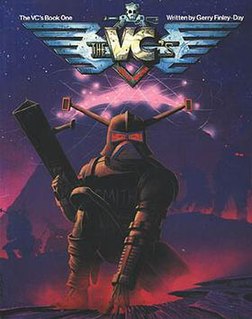
The V.C.s was a future war series that appeared in the science fiction comic 2000 AD No. 140 – 178 (1979–1980). Written by Gerry Finley-Day, the first episode was drawn by Mike McMahon who designed the craft and the main characters. The main series artists were Cam Kennedy, Garry Leach and John Richardson. Dan Abnett has recently finished the series at Book 5 with the help of artist Anthony Williams who has been working with Abnett on this for quite a while.

Diamond Dogs, Turquoise Days is a 2003 compilation of two science fiction novellas by writer Alastair Reynolds. Both are set in the Revelation Space universe, but are almost entirely unconnected with the plots of any of the novels in the same story arc.
The Commonwealth Saga is a series of science fiction novels by British science fiction writer Peter F. Hamilton. This saga consists of the novels Pandora's Star (2004) and Judas Unchained (2005). Hamilton has also written several books set in the same literary universe. Misspent Youth (2002) takes place 340 years before the events of Pandora's Star. The Void Trilogy, consisting of The Dreaming Void (2008), The Temporal Void (2009), and The Evolutionary Void (2010), takes place 1,200 years after the events of Judas Unchained; several of the main characters from Judas Unchained and Pandora's Star also appear in the Void trilogy.

City of Pearl is a science fiction novel by British writer Karen Traviss. Published in March, 2004, it is the first book of the Wess'Har Series. Among the main characters are Shan Frankland, the hardened cop and forceful commander; Josh Garrod, the devout Christian and gentle leader; Aras, the lonely Wess'har, outcast by his horrible disease; and Lindsay Neville, the Marines Commander dealing with an unplanned pregnancy. City of Pearl is a book that deals with morals, especially concerning environmentalism, and keeps action sequences to a minimum.

The Martians, also known as the Invaders, are the fictional race of extraterrestrials from the H.G. Wells 1898 novel The War of the Worlds. They are the main antagonists of the novel, and their efforts to exterminate the populace of the Earth and claim the planet for themselves drive the plot and present challenges for the novel's human characters. They are notable for their use of extraterrestrial weaponry far in advance of that of mankind at the time of the invasion.

Fantastic Four 2099 was a comic book series published by Marvel Comics, featuring the adventures of the Fantastic Four in the alternate future of Marvel 2099 (Earth-928). It ran for eight issues in 1996.
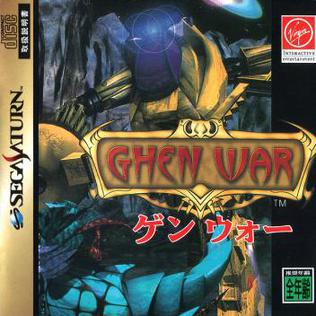
Ghen War is a first-person shooter video game for the Sega Saturn console. It was developed by American studio Jumpin' Jack Software and published by Sega in 1995. The game centers around a member of a mining crew, with an artificial powered exoskeleton resembling a power-loader. The crew, specifically the protagonist, must fight off a once-friendly alien race known as the Ghen, who suddenly turn on the humans.

After Doomsday is a science fiction novel by American writer Poul Anderson. It was published as a complete novel in 1962, having been serialized as The Day after Doomsday in the magazine Galaxy, between December 1961 and February 1962.
The planetary systems of stars other than the Sun and the Solar System are a staple element in many works of the science fiction genre.
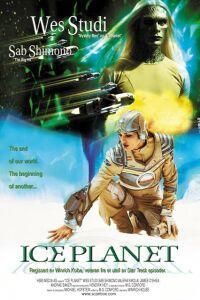
Ice Planet is a 2001 Canadian-German science fiction film produced as a pilot movie for an intended TV series. The film was directed by Winrich Kolbe and its cast included Wes Studi as Commander Trager.
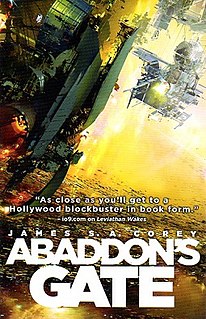
Abaddon's Gate is a science fiction novel by James S. A. Corey. It is about a conflict in the Solar System that involves Earth, Mars, and the Asteroid Belt. It is the third title of The Expanse series and is preceded by Leviathan Wakes and Caliban's War. The series is continued in Cibola Burn. The book was released on 4 June 2013, as well released as an audiobook by Audible, narrated by Jefferson Mays.

The Engines of God is a science fiction novel by American author Jack McDevitt.

Starship HLS, or Starship Human Landing System, is a lunar lander variant of the Starship spacecraft that will transfer astronauts from a lunar orbit to the surface of the Moon and back. It is being designed and built by SpaceX under contract to NASA as a critical element of NASA's Artemis program to land a crew on the Moon in the 2020s.
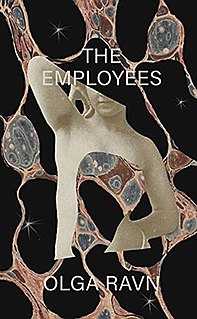
The Employees is a novel by Danish writer Olga Ravn published October 1, 2020. The novel has since been translated into English by Martin Aitken. The novel details the interactions between human and android crew members aboard a futuristic spacecraft as they encounter and react to a series of mysterious alien objects.















